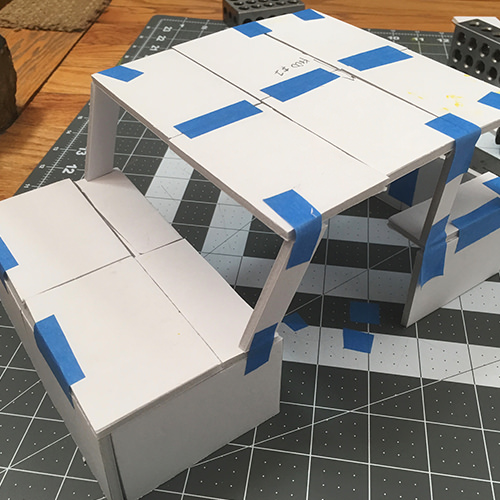Just as the latest installment of the Marvel action franchise “Avengers: Endgame” hits theaters, an increasing number of physical stores are disappearing this year as if Thanos, the movie villain who wiped out half the population of the universe, turned them into dust. It’s enough suspense to keep retailers on the edge of their seats worrying if they’re going to become the next victims of the dreaded Amazon effect.
But the message for retailers at Design Thinking 2019 was that the future doesn’t have to be an endless Infinity War of brick-and-mortar retailers vs. online retailers. What you might call the “Avengers of Retail” recently gathered in Austin to share their thoughts about how these two forces can peacefully coexist by applying experience strategy and service design to bring balance to customers’ lives.
Looking a lot like Tony Stark, speaker Michael Brown, the Chief Design Officer of Dick’s Sporting Goods, took the stage to present his plan to fight off the Thanos/Amazon effect. He explained that although Dick’s has been in business for 70 years and has 700 stores across 38 states, his mission was to challenge the traditional culture of the organization with design-fueled internal startups; live its values as a local sporting goods expert and supporter of youth sports and fitness; and battle commoditization by transforming from a place where people “just buy stuff” to a place where people want to go for meaningful experiences.
Experiences are essential to creating emotional bonds between brands and consumers, but they exist across a customer journey consisting of many touchpoints. Cantina has identified 6 key areas for retailers to unlock success throughout those journeys (think of them as the 6 Infinity Gem Stones if you’re a Marvel fan):
- Experiences
- Immersion
- Personalization
- Community
- Ubiquity
- Delivery
Experiences Matter
Cantina knows that in-store experiences like Dick’s rock climbing walls are the kryptonite of online retailers, with ample evidence from many retail innovators. But experiences (in-store or across other physical and digital touchpoints) are only successful when based on a deep understanding of customer needs and desires; are cohesive across touchpoints; and align with the company’s values and organizational operations and culture.
As mentioned in Woo, Wow, and Win: Service Design, Strategy, and the Art of Customer Delight, research shows that 91% of customers have chosen to not continue engaging a company due to bad service experience, and a dissatisfied customer tells 9-15 people. It can even take 12 positive experiences to make up for an unresolved negative one. That’s why our research team performs the insights groundwork that underpins our strategies and addresses how to turn an ow into a wow.
Immersion: Blurring the Lines
Walmart had a wow moment earlier this year with its pop-up roadshow How to Train Your Dragon VR experience, that set the bar higher for amazingly immersive experiences at retail. But, as good as it was, according to the BRP Special Report: The Future Store, customer interest in Augmented and Virtual Reality technologies is outpacing retailer adoption, with 32% of consumers likely to shop at a store offering an AR experience over a retailer that doesn’t offer AR, and 29% desiring a VR experience as part of their shopping environment.
Clearly, it’s time for retailers to drive more immersive experiences that customers desire, and that enhance the shopping experience without replacing human interaction. Former Cantina employee Scott Evernden, created Infinite Stores, one of the first VR shopping experiences where one could, for instance, flip through a virtual comic book in an immersive store environment. “While much progress has been made, retailers are still in the early stages of blending the physical and the digital and we’re busy working on that future,” he says.
Personalization: Everyone Wants a Jarvis Assistant
Another theme of Design Thinking 2019 was Artificial Intelligence’s impact on retail to drive higher levels of personalized (and more human-like) interaction. The IDC Worldwide Semiannual Artificial Intelligence Systems Spending Guide reports: ‘Retail is leading global spend on AI systems this year, with the category projected to invest $5.9 billion on solutions like automated customer service agents, shopping advisers, and product recommendation platforms.’
European retailers such as Sephora, ASOS, and Zara are already experiencing the benefits of AI, including increased store visits, higher revenues, reduced costs, and more personalized customer journeys. Whether it’s a chatbot, an Alexa Skill that we’ve created to enable us to reserve conference rooms at Cantina with our voices, or another AI application, we’re finding ways to bring humanity back to algorithms.
Community: Membership Has Its Privileges
Loyalty programs that reward customers with better (and more exclusive) experiences are driving stronger ties that build trust and increase sales. The Nike Live experiential store, available only to members of the NikePlus loyalty program, caters to the local tastes of its location and delights members while also inspiring non-members to join. Similarly, Sephora’s Beauty Insider online member’s only community foster better relationships (and keep social platform-like engagement within its own domain).
Ubiquity: Theater in the Round
In the book Woo, Wow, and Win: Service Design, Strategy, and the Art of Customer Delight the authors note how Nordstrom gets three to four times more money from multichannel customers than it does from those who engage in just one way, writing: ‘cross-platform sales are accretive and not cannibalistic; that is the total value of a customer grows when he or she engages with you across multiple platforms.’
Keeping this in mind, Cantina’s integrated service design approach takes into account an orchestrated experience between all parts of the service, from people to places to interfaces. We focus on ubiquity and consistency both onstage facing customers, and in behind-the-scenes business processes.
On the frontlines, retailers like Rebecca Minkoff are creating stores of the future with tech innovation. Cantina is helping shop floor personnel have the autonomy (and necessary training) to take customer engagements into their own hands and help remove pain points.
Brian Wilkinson, Principal Creative Technologist at Cantina, who has worked on myriad innovative in-store touchpoints involving Internet of Things and other tech, says, “What happens in real life is increasingly as measurable as what happens online. Just as you can look at the bounce rate for a website, you can measure consumer reactions to the content they’re engaging with at the point of sale. What are their facial reactions, how much time do they spend looking at a product? Of course, what we create must align with a human-centered experience and maintain privacy.”
Delivery: Seamless Wins the Last Mile
Michael Brown from Dick’s Sporting Goods acknowledged that to combat Amazon, Dick’s enabled online ordering in stores, and 36% of retailers have implemented virtual inventories and another 27% plan to implement this within three years. Similarly, in-store pickup of online ordering is being touted by Target and others. Consumers want to engage at retail, but they also want convenience, and 55% of us are more likely to shop at a store with self-checkout. Amazon is struggling with challenges to a cashierless store experience, but we’re pretty sure Jeff Bezos will find a way to make it happen.
And for those of us too lazy to go to a store at all, our robot overlords like Ultron (I mean Amazon Scout delivery vehicles and Stop & Shop self-driving mini grocery stores), are solving the last-mile delivery challenge.
It’s Not Over After the Credits Roll
In the action movie Captain Marvel, set during the 90s, the titular heroine falls from space and lands on a Blockbuster Video store. It’s a winking reference back to an era when thousands of video rental stores littered the landscape and would be easy targets. Today, in a sign of our disruptive times, there is only one single Blockbuster retail location left, and streaming services rule.
In a bellwether of a retail landscape in flux, while Sears stores are being torn down, originally online-only retailers like Casper Mattress, Wayfair, Warby Parker, and Allbirds are building out physical retail locations because they want experiences, community, immersion, personalization, ubiquity and seamless delivery. What’s old has become new again, but with a design-focused plot twist.
Ultimately, the most successful retailers understand that the value of design thinking is not about chasing new technology and trends just to be cutting edge, it’s about an increased focus on what’s best for customers first and fulfilling their unmet needs. Dick’s doesn’t want to out-Amazon Amazon – they want to design their best self from the inside out and outside in. And that way, we all win.
Now pass the popcorn!





